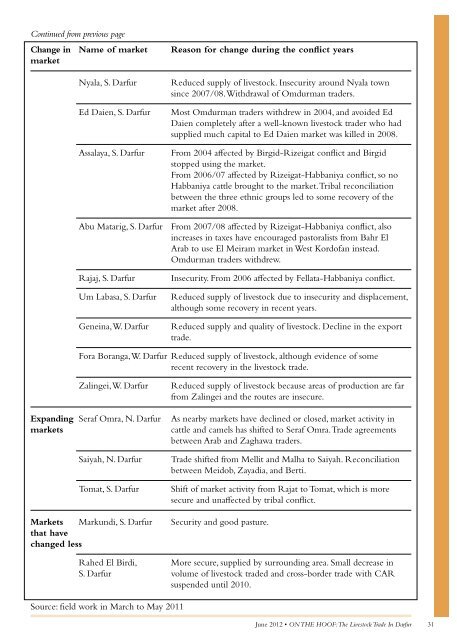cont<strong>in</strong>u<strong>in</strong>g to function relatively unchangedcompared with <strong>the</strong> pre-conflict years: Markundiand Rahed El Birdi <strong>in</strong> Rahed El Birdi locality.This area has generally rema<strong>in</strong>ed calmer and moresecure than most o<strong>the</strong>r parts of South <strong>Darfur</strong>s<strong>in</strong>ce 2003.The reasons for <strong>the</strong> shifts <strong>in</strong> market activitybetween secondary markets <strong>in</strong> <strong>Darfur</strong>’s three statescan be summarized as:(1) <strong>in</strong>security <strong>in</strong> certa<strong>in</strong> areas affect<strong>in</strong>g <strong>the</strong>supply of livestock to <strong>the</strong> market and <strong>the</strong>will<strong>in</strong>gness of traders to trek livestock out of<strong>the</strong> area, for example, affect<strong>in</strong>g Ed Daien;(2) greater security <strong>in</strong> o<strong>the</strong>r areas wherepastoralists and agro-pastoralists can graze<strong>the</strong>ir livestock more securely. This hasboosted market activity <strong>in</strong> some placessuch as Tomat <strong>in</strong> South <strong>Darfur</strong>;(3) certa<strong>in</strong> ethnic groups not hav<strong>in</strong>g access tocerta<strong>in</strong> markets due to tribal conflict. This isa particular feature of livestock trad<strong>in</strong>g <strong>in</strong>South <strong>Darfur</strong>, affect<strong>in</strong>g many markets,<strong>in</strong>clud<strong>in</strong>g Assalaya near Ed Daien, AbuMutarig, and Rajaj markets (see Table 2). In2011, dur<strong>in</strong>g <strong>the</strong> period of field work, itwas strik<strong>in</strong>g that <strong>the</strong> Habbaniya had lostaccess to many markets that <strong>the</strong>y wouldhave used before <strong>the</strong> conflict because oftribal hostilities; <strong>the</strong>y no longer had accessto markets <strong>in</strong> Rizeigat or Fellata territoryand were us<strong>in</strong>g Gareida market <strong>in</strong>stead. At<strong>the</strong> time of writ<strong>in</strong>g <strong>in</strong> 2012, access to somemarkets had improved due to localagreements between different ethnic groups,but <strong>the</strong>se are constantly shift<strong>in</strong>g dynamics;(4) small rural markets collaps<strong>in</strong>g and allmarket activity shift<strong>in</strong>g to one secondarymarket, for example to Seraf Omra <strong>in</strong>North <strong>Darfur</strong>;(5) some localities charg<strong>in</strong>g high rates oftaxation, driv<strong>in</strong>g traders to markets wheretaxes are lower, for example from AbuMatarig market (Abu Matarig locality) <strong>in</strong>South <strong>Darfur</strong> to El Meiram <strong>in</strong> SouthKordofan.For some markets, trad<strong>in</strong>g activity has waxedand waned accord<strong>in</strong>g to fluctuat<strong>in</strong>g conflictdynamics. (See Box 3 for an overview of <strong>the</strong><strong>Darfur</strong> conflict). This may be <strong>the</strong> result of localconflict dynamics as hostilities between ethnicgroups <strong>in</strong>tensify or subside. For example, <strong>in</strong>Assalaya market, some 40 km west of Ed Daien,<strong>the</strong> livestock trade decl<strong>in</strong>ed <strong>in</strong> 2004 when <strong>the</strong>Birgid–Rizeigat conflict was at its height and <strong>the</strong>Birgid no longer brought <strong>the</strong>ir animals to <strong>the</strong>market. It was aga<strong>in</strong> negatively affected <strong>in</strong> 2006when <strong>the</strong> Rizeigat–Habbaniya conflict meant that<strong>the</strong> Habbaniya stopped us<strong>in</strong>g <strong>the</strong> market.However, reconciliation between <strong>the</strong> Rizeigat andBirgid, and between <strong>the</strong> Rizeigat and Habbaniya<strong>in</strong> 2008 triggered a revival <strong>in</strong> market activity as allthree groups used <strong>the</strong> market once aga<strong>in</strong>.Fluctuat<strong>in</strong>g trad<strong>in</strong>g activity may also be affectedby higher-level political and conflict dynamics at<strong>the</strong> national or regional level. See Box 6 on ForaBoranga market, where trad<strong>in</strong>g activity has waxedand waned accord<strong>in</strong>g to <strong>the</strong> state of relationsbetween <strong>the</strong> Sudanese government <strong>in</strong> Khartoumand <strong>the</strong> Chadian government <strong>in</strong> N’Djamena.Table 2. Shifts <strong>in</strong> market activity <strong>in</strong> <strong>Darfur</strong>’s secondary livestock markets dur<strong>in</strong>g <strong>the</strong> conflictyears, until 2011Change <strong>in</strong> Name of marketmarketContract<strong>in</strong>g El Fasher, N. <strong>Darfur</strong>marketsMellit, N. <strong>Darfur</strong>Malha, N. <strong>Darfur</strong>Reason for change dur<strong>in</strong>g <strong>the</strong> conflict yearsReduced supply of livestock and fall <strong>in</strong> export trade.Limited access for certa<strong>in</strong> ethnic groups supply<strong>in</strong>g livestock.Very high taxes. No bank<strong>in</strong>g facilities. Kordofan marketsreplac<strong>in</strong>g Mellit.Groups that used to supply <strong>the</strong> market have stopped eg.,Zayadia, Kababish. Omdurman traders withdrew.Cont<strong>in</strong>ued on next page30
Cont<strong>in</strong>ued from previous pageChange <strong>in</strong> Name of marketmarketNyala, S. <strong>Darfur</strong>Ed Daien, S. <strong>Darfur</strong>Assalaya, S. <strong>Darfur</strong>Reason for change dur<strong>in</strong>g <strong>the</strong> conflict yearsReduced supply of livestock. Insecurity around Nyala towns<strong>in</strong>ce 2007/08. Withdrawal of Omdurman traders.Most Omdurman traders withdrew <strong>in</strong> 2004, and avoided EdDaien completely after a well-known livestock trader who hadsupplied much capital to Ed Daien market was killed <strong>in</strong> 2008.From 2004 affected by Birgid-Rizeigat conflict and Birgidstopped us<strong>in</strong>g <strong>the</strong> market.From 2006/07 affected by Rizeigat-Habbaniya conflict, so noHabbaniya cattle brought to <strong>the</strong> market. Tribal reconciliationbetween <strong>the</strong> three ethnic groups led to some recovery of <strong>the</strong>market after 2008.Abu Matarig, S. <strong>Darfur</strong> From 2007/08 affected by Rizeigat-Habbaniya conflict, also<strong>in</strong>creases <strong>in</strong> taxes have encouraged pastoralists from Bahr ElArab to use El Meiram market <strong>in</strong> West Kordofan <strong>in</strong>stead.Omdurman traders withdrew.Rajaj, S. <strong>Darfur</strong>Um Labasa, S. <strong>Darfur</strong>Gene<strong>in</strong>a, W. <strong>Darfur</strong>Insecurity. From 2006 affected by Fellata-Habbaniya conflict.Reduced supply of livestock due to <strong>in</strong>security and displacement,although some recovery <strong>in</strong> recent years.Reduced supply and quality of livestock. Decl<strong>in</strong>e <strong>in</strong> <strong>the</strong> exporttrade.Fora Boranga, W. <strong>Darfur</strong> Reduced supply of livestock, although evidence of somerecent recovery <strong>in</strong> <strong>the</strong> livestock trade.Zal<strong>in</strong>gei, W. <strong>Darfur</strong>Expand<strong>in</strong>g Seraf Omra, N. <strong>Darfur</strong>marketsSaiyah, N. <strong>Darfur</strong>Tomat, S. <strong>Darfur</strong>Reduced supply of livestock because areas of production are farfrom Zal<strong>in</strong>gei and <strong>the</strong> routes are <strong>in</strong>secure.As nearby markets have decl<strong>in</strong>ed or closed, market activity <strong>in</strong>cattle and camels has shifted to Seraf Omra. <strong>Trade</strong> agreementsbetween Arab and Zaghawa traders.<strong>Trade</strong> shifted from Mellit and Malha to Saiyah. Reconciliationbetween Meidob, Zayadia, and Berti.Shift of market activity from Rajat to Tomat, which is moresecure and unaffected by tribal conflict.Markets Markundi, S. <strong>Darfur</strong> Security and good pasture.that havechanged lessRahed El Birdi, More secure, supplied by surround<strong>in</strong>g area. Small decrease <strong>in</strong>S. <strong>Darfur</strong> volume of livestock traded and cross-border trade with CARsuspended until 2010.Source: field work <strong>in</strong> March to May 2011June 2012 • ON THE HOOF: The <strong>Livestock</strong> <strong>Trade</strong> In <strong>Darfur</strong> 31

















